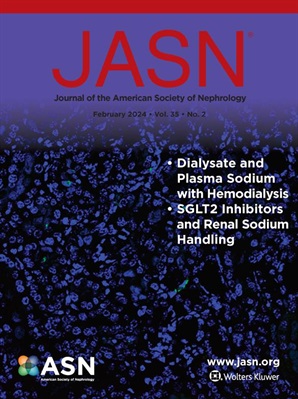微生物与健康小鼠肾小球滤过率及CKD的关系。
IF 9.4
1区 医学
Q1 UROLOGY & NEPHROLOGY
引用次数: 0
摘要
微生物参与宿主的多种生理和病理生理过程。在这项研究中,我们检验了微生物调节健康和慢性肾脏疾病的肾小球滤过率(GFR)的假设。方法为了揭示肠道微生物群对健康和慢性肾脏疾病(CKD)模型肾脏功能的影响,我们检测了肠道微生物被操纵时小鼠的GFR、血浆肌酐和肾脏组织学。结果在健康小鼠中,当肠道菌群受到抑制(口服抗生素)或缺乏(无菌)时,GFR显著升高。在腺嘌呤饮食诱导GFR受损的CKD小鼠中,用抗生素抑制肠道微生物也会增加GFR。在服用腺嘌呤饮食的女性中,与单独服用腺嘌呤相比,抗生素在第4周和第6周增加了GFR。在男性中,抗生素使GFR在第2周升高。腺嘌呤饮食显著增加血浆肌酐和肾纤维化;这在两性中都被抗生素抑制了。为了探索其机制,我们使用钠-葡萄糖共转运蛋白2抑制剂恩格列净检验了小管肾小球反馈改变导致GFR升高的假设;依格列净损害近端小管的Na+重吸收,改变小管-肾小球反馈。依帕列净损害了抗生素诱导的GFR在第3周升高,但在第5周没有,这表明改变的小管肾小球反馈有助于GFR的初始升高。结论微生物组在“设定”基线GFR中起关键作用,其机制部分涉及小管肾小球反馈,抑制肠道微生物甚至可以提高CKD小鼠的GFR。本文章由计算机程序翻译,如有差异,请以英文原文为准。
Microbes and Glomerular Filtration Rate in Health and CKD in Mice.
BACKGROUND
Microbes are implicated in a variety of host physiological and pathophysiological processes. In this study, we tested the hypothesis that microbes modulate glomerular filtration rate (GFR) in health and chronic kidney disease.
METHODS
To uncover the effect of gut microbiota on kidney function in health and in a chronic kidney disease (CKD) model, we examined GFR, plasma creatinine, and kidney histology in mice when gut microbes were manipulated.
RESULTS
In healthy mice, GFR was significantly increased when gut microbiota were either suppressed (oral antibiotics) or absent (germ-free). In mice challenged with adenine diet to induce CKD with impaired GFR, suppressing gut microbes with antibiotics also increased GFR. In females on an adenine diet, antibiotics increased GFR versus adenine alone on weeks 4 and 6. In males, antibiotics elevated GFR on week 2. Adenine diet significantly increased plasma creatinine and kidney fibrosis; this was suppressed by antibiotics in both sexes. To explore the mechanism, we tested the hypothesis that altered tubuloglomerular feedback contributes to elevated GFR using the sodium-glucose cotransporter 2 inhibitor empagliflozin; empagliflozin impairs Na+ reabsorption in the proximal tubule, altering tubuloglomerular feedback. Empagliflozin impaired antibiotic-induced GFR increases on week 3 but not week 5, suggesting that altered tubuloglomerular feedback contributes to the initial increase in GFR.
CONCLUSIONS
The microbiome plays a key role in 'setting' baseline GFR by a mechanism which partially involves tubuloglomerular feedback, and, suppressing gut microbes can elevate GFR even in CKD mice.
求助全文
通过发布文献求助,成功后即可免费获取论文全文。
去求助
来源期刊
CiteScore
22.40
自引率
2.90%
发文量
492
审稿时长
3-8 weeks
期刊介绍:
The Journal of the American Society of Nephrology (JASN) stands as the preeminent kidney journal globally, offering an exceptional synthesis of cutting-edge basic research, clinical epidemiology, meta-analysis, and relevant editorial content. Representing a comprehensive resource, JASN encompasses clinical research, editorials distilling key findings, perspectives, and timely reviews.
Editorials are skillfully crafted to elucidate the essential insights of the parent article, while JASN actively encourages the submission of Letters to the Editor discussing recently published articles. The reviews featured in JASN are consistently erudite and comprehensive, providing thorough coverage of respective fields. Since its inception in July 1990, JASN has been a monthly publication.
JASN publishes original research reports and editorial content across a spectrum of basic and clinical science relevant to the broad discipline of nephrology. Topics covered include renal cell biology, developmental biology of the kidney, genetics of kidney disease, cell and transport physiology, hemodynamics and vascular regulation, mechanisms of blood pressure regulation, renal immunology, kidney pathology, pathophysiology of kidney diseases, nephrolithiasis, clinical nephrology (including dialysis and transplantation), and hypertension. Furthermore, articles addressing healthcare policy and care delivery issues relevant to nephrology are warmly welcomed.

 求助内容:
求助内容: 应助结果提醒方式:
应助结果提醒方式:


